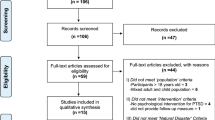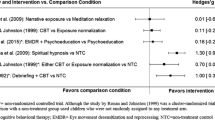Abstract
Background
There is a wide range of mental and behavioral sequel in children following disasters, which can last long. This review discusses the nature and extent of the psychiatric problems, their management options and process to organize the psychological interventions for affected children.
Data sources
Literatures were searched through PubMed with the words “children, disaster, psychiatry, and mental health” and relevant cross references were included in the review.
Results
Proportions of children having posttraumatic symptoms or syndromal diagnoses vary in different studies depending on various factors like nature and severity of disaster, diagnostic criteria used, cultural issues regarding meaning of trauma, support available, etc. Common psychiatric manifestations among children include acute stress reactions, adjustment disorder, depression, panic disorder, post-traumatic stress disorder, anxiety disorders specific to childhood and psychotic disorders. Comorbidities and sub-clinical syndromes are also common. Most of the post-disaster mental health interventions can be provided in the community by the local disaster workers. Supportive counselling, cognitive behavior therapy, brief trauma/grief-focused psychotherapy, and play therapy are the commonly utilized methods of psychological intervention, which can be given in groups. Information about the efficacy of medications is still emerging, while many are being used and found useful.
Conclusions
Following disaster, systematic screening for psychological problems in children is suggested. An integrated approach using psycho-socio-educational and clinical interventions is expected to be effective.
Similar content being viewed by others
References
American Academy of Child and Adolescent Psychiatry. Practice parameters for the assessment and treatment of posttraumatic stress disorder in children and adolescents. J Am Acad Child Adolesc Psychiatry 1998;37(10 Suppl):4S–26S.
Amaya-Jackson L. Posttraumatic stress disorder in children and adolescents. In: Sadock B, Sadock V, eds. Kaplan and Sadock’s Comprehensive textbook of psychiatry, 7th ed. Philadelphia: Lippincott Williams and Wilkins,2000:2763–2769.
Kar N, Jagadisha, Murali N. Post-traumatic stress disorder in children following disaster. Kerala J Psychiatry 2001;16:7–14.
Pynoos RS, Goenjian A, Tashjian M, Karakashian M, Manjikian R, Manoukian G, et al. Post-traumatic stress reactions in children after the 1988 Armenian earthquake. Br J Psychiatry 1993;163:239–247.
Davidson J, Smith R. Traumatic experiences in psychiatric outpatients. J Trauma Stress 1990;3:459–475.
Hoffman MA, Bizzman A. Attributions and responses to the Arab Israeli conflict: a developmental analysis. Child Dev 1996;67:117–128.
Kar N. Psychosocial issues following a natural disaster in a developing country: a qualitative longitudinal observational study. Int J Disast Med 2006;4:169–176.
Kar N, Bastia BK. Post-traumatic stress disorder, depression and generalised anxiety disorder in adolescents after a natural disaster: a study of comorbidity. Clin Pract Epidemol Ment Health 2006;2:17.
Math SB, Tandon S, Girimaji SC, Benegal V, Kumar U, Hamza A, et al. Psychological impact of the tsunami on children and adolescents from the Andaman and Nicobar islands. Prim Care Companion J Clin Psychiatry 2008;10:31–37.
McFarlane AC. Post-traumatic phenomena in a longitudinal study of children following a natural disaster. J Am Acad Child Adolesc Psychiatry 1987;26:764–769.
Kar N, Mohapatra PM, Nayak KC, Pattanaik P, Swain SP, Kar HC. Post-traumatic stress disorder in children and adolescents one year after a super-cyclone in Orissa, India: exploring cross-cultural validity and vulnerability factors. BMC Psychiatry 2007;7:8.
Shannon MP, Lonigan CJ, Finch AJ, Taylor CM. Children exposed to disaster: epidemiology of post traumatic symptoms and symptom profile. J Am Acad Child Adolesc Psychiatry 1994;33:80–93.
Asarnow J, Glenn S, Pynoos RS, Nahum J, Guthrie D, Cantwell DP, et al. When earth stops shaking: earthquake sequelae among children diagnosed for pre-earthquake psychopathology. J Am Acad Child Adolesc Psychiatry 1999;38:1016–1023.
Schwarz E, Perry BD. The post-traumatic response in children and adolescents. Psychiatr Clin North Am 1994;17:311–326.
Berman H. Health in the aftermath of violence: a critical narrative study of children of war and children of battered women. Can J Nurs Res 1999;31:89–109.
Drell MJ, Siegel CH, Gaensbauer TJ. Post traumatic stress disorder. In: Zeanah CH, eds. Handbook of Infant Mental Health. New York: Guildford, 1993:291–304.
Terr LC. Chowchilla revisited: the effects of psychic trauma four years after a school-bus kidnapping. Am J Psychiatry 1983;140:1543–1550.
Famularo R, Fenton T, Augustyn M, Zuckerman B. Persistence of pediatric post traumatic stress after two years. Child Abuse Negl 1996;20:1245–1248.
Spiegel D. Multiple personality as a post traumatic stress disorder. Psychiatr Clin North Am 1984;7:101–110.
Malmquist CP. Children who witness parental murder: post traumatic aspects. J Am Acad Child Psychiatry 1986;25:320–325.
Laor N, Wolmer L, Mayes LC, Gershon A, Weizman R, Cohen DT. Israeli preschool children under Scuds: a 30-month follow-up. J Am Acad Child Adolesc Psychiatry 1997;36:349–356.
Shaw JA, Applegate B, Tanner S, Perez D, Rothe E, Campo-Bowen AE, et al. Psychological effects of Hurricane Andrew on an elementary school population. J Am Acad Child Adolesc Psychiatry 1995;34:1185–1192.
Goenjian AK, Karayan I, Pynoos RS, Minassian D, Najarian LM, Steinberg AM, et al. Outcome of psychotherapy among early adolescents after trauma. Am J Psychiatry 1997;154:536–542.
Nader K, Pynoos R, Fairbanks L, Frederick C. Children’s PTSD reactions one year after a sniper attack at their school. Am J Psychiatry 1990;147:1526–1530.
Somasundaram DJ, van de Put WA. Management of trauma in special populations after a disaster. J Clin Psychiatry 2006;67Suppl 2:64–73.
Vijayakumar L, Kannan GK, Ganesh Kumar B, Devarajan P. Do all children need intervention after exposure to tsunami? Int Rev Psychiatry 2006;18:515–522.
Foy DW, Madvig BT, Pynoos RS, Camilleri AJ. Etiologic factors in the development of posttraumatic stress disorder in children and adolescents. J Sch Psychol 1996;34:133–145.
Catani C, Jacob N, Schauer E, Kohila M, Neuner F. Family violence, war, and natural disasters: a study of the effect of extreme stress on children’s mental health in Sri Lanka. BMC Psychiatry 2008;8:33.
Rutter M. Continuities and discontinuities from infancy. In: Osofsky JD, eds. Handbook of infant development, 2nd ed. New York: Wiley, 1987:1256–1296.
Hoare P. Essential child psychiatry. Edinburgh: Churchill Livingstone, 1993.
Kiliç EZ, Ozgüven HD, Sayil I. The psychological effects of parental mental health on children experiencing disaster: the experience of Bolu earthquake in Turkey. Fam Process 2003;42:485–495.
Goenjian AK, Walling D, Steinberg AM, Karayan I, Najarian LM, Pynoos R. A prospective study of posttraumatic stress and depressive reactions among treated and untreated adolescents 5 years after a catastrophic disaster. Am J Psychiatry 2005;162:2302–2308.
Goenjian AK, Walling D, Steinberg AM, Roussos A, Goenjian HA, Pynoos RS. Depression and PTSD symptoms among bereaved adolescents 6(1/2) years after the 1988 Spitak earthquake. J Affect Disord 2009;112:81–84. Epub 2008 Jun 10.
Caffo E, Belaise C. Psychological aspects of traumatic injury in children and adolescents. Child Adolesc Psychiatr Clin N Am 2003;12:493–535.
Wolfe DA, Sas L, Wekerle C. Factors associated with the development of post traumatic stress disorder among child victims of sexual abuse. Child Abuse Negl 1994;18:37–50.
Scheeringa MS, Zeanah CH, Drell MJ, Larrieu JA. Two approaches to diagnosing post traumatic stress disorder in infancy and early childhood. J Am Acad Child Adolesc Psychiatry 1995;34:191–200.
Sack WH, Angell RH, Kinzie JD, Rath B. The psychiatric effects of massive trauma on Cambodian Children, II: The family, the home and the school. J Am Acad Child Psychiatry 1986;25:377–383.
Rigamer EF. Psychological management of children in a national crisis. J Am Acad Child Psychiatry 1986;25:364–369.
Berman H. Stories of growing up amid violence by refugee children of war and children of battered women living in Canada. Image J Nurs Sch 1999;31:57–63.
Kar N, Misra BN. Mental health care following disasters: a handbook for disaster workers. Quality of Life Research and Development Foundation: Bhubaneswar, 2008.
Jones L. Responding to the needs of children in crisis. Int Rev Psychiatry 2008;20:291–303.
Almqvist K, Brandell-Forsberg M. Refugee children in Sweden: post-traumatic stress disorder in Iranian preschool children exposed to organized violence. Child Abuse Negl 1997;21:351–366.
Austin LS, Godleski LS. Therapeutic approaches for survivors of disaster. Psychiatr Clin North Am 1999;22:897–910.
Pfefferbaum B. Caring for children affected by disaster. Child Adolesc Psychiatr Clin N Am 1998;7:579–597.
Nagao K, Okuyama M, Miyamoto S, Haba T. Treating early mental health and post-traumatic symptoms of children in the Hanshin-Awaji earthquake. Acta Paediatr Jpn 1995;37:745–754.
Norris FH, Friedman MJ, Watson PJ. 60,000 disaster victims speak: Part II. Summary and implications of the disaster mental health research. Psychiatry 2002;65:240–260.
Pfefferbaum B, Call JA, Sconzo GM. Mental health services for children in the first two years after the 1995 Oklahoma City terrorist bombing. Psychiatr Serv 1999;50:956–958.
Goenjian AK, Molina L, Steinberg AM, Fairbanks LA, Alvarez ML, Goenjian HA, et al. Posttraumatic stress and depressive reactions among Nicaraguan adolescents after hurricane Mitch. Am J Psychiatry 2001;158:788–794.
Coates S, Schechter D. Preschoolers traumatic stress post-9/11: relational and developmental perspectives. Psychiatr Clin North Am 2004;27:473–489.
Covell NH, Donahue SA, Allen G, Foster MJ, Felton CJ, Essock SM. Use of Project Liberty counseling services over time by individuals in various risk categories. Psychiatr Serv 2006;57:1268–1270.
Fetter JC. Psychosocial Response to Mass Casualty Terrorism: Guidelines for Physicians. Prim Care Companion J Clin Psychiatry 2005;7:49–52.
Silva RR, Cloitre M, Davis L, Levitt J, Gomez S, Ngai I, et al. Early intervention with traumatized children. Psychiatr Q 2003;74:333–347.
Donnelly CL, Amaya-Jackson L. Post-traumatic stress disorder in children and adolescents: epidemiology, diagnosis and treatment options. Paediatr Drugs 2002;4:159–170.
Shooshtary MH, Panaghi L, Moghadam JA. Outcome of cognitive behavioral therapy in adolescents after natural disaster. J Adolesc Health 2008;42:466–472.
Giannopoulou I, Dikaiakou A, Yule W. Cognitive-behavioural group intervention for PTSD symptoms in children following the Athens 1999 earthquake: a pilot study. Clin Child Psychol Psychiatry 2006;11:543–553.
NICE (National Institute for Clinical Excellence). Posttraumatic stress disorder (PTSD): The management of PTSD in adults and children in primary and secondary care. NICE Clinical Guideline No. 26. London: National Institute for Clinical Excellence, 2005. http://www.nice.org.uk/nicemedia/pdf/CG026NICEguideline.pdf.
Pynoos RS, Nader K. Psychological first aid and treatment approach to children exposed to community violence: research implications. J Trauma Stress 1988;1:445–473.
Stoddard FJ. Care of infants, children and adolescents with burn injuries. In: Lewis M, eds. Child and adolescent psychiatry. Washington DC: American Psychiatric Press, 1996:1016–1033.
Young JG, Kaplan D, Pascualvaca D, Brasic JR. Psychiatric examination of the infant, child and adolescent. In: Kaplan HI, Sadock BJ, eds. Comprehensive textbook of psychiatry. Baltimore: William and Wilkins, 1995:2169–2206.
Kernberg PF. Individual Psychotherapy. In: Kaplan HI, Sadock BJ, eds. Comprehensive textbook of psychiatry. Baltimore: William and Wilkins, 1995:2399–2412.
Putnam FW, Hulsmann JE. Pharmacotherapy for survivors of childhood trauma. Semin Clin Neuropsychiatry 2002;7:129–136.
Donnelly CL. Pharmacologic treatment approaches for children and adolescents with posttraumatic stress disorder. Child Adolesc Psychiatr Clin N Am 2003;12:251–269.
Cohen JA, Mannarino AP, Rogal S. Treatment practices for childhood posttraumatic stress disorder. Child Abuse Negl 2001;25:123–135.
Putnam FW, Hulsmann JE. Pharmacotherapy for survivors of childhood trauma. Semin Clin Neuropsychiatry 2002;7:129–136.
Donnelly CL. Pharmacologic treatment approaches for children and adolescents with posttraumatic stress disorder. Child Adolesc Psychiatr Clin N Am 2003;12:251–269.
Cohen JA, Mannarino AP, Rogal S. Treatment practices for childhood posttraumatic stress disorder. Child Abuse Negl 2001;25:123–135.
Author information
Authors and Affiliations
Corresponding author
Rights and permissions
About this article
Cite this article
Kar, N. Psychological impact of disasters on children: review of assessment and interventions. World J Pediatr 5, 5–11 (2009). https://doi.org/10.1007/s12519-009-0001-x
Received:
Accepted:
Published:
Issue Date:
DOI: https://doi.org/10.1007/s12519-009-0001-x




